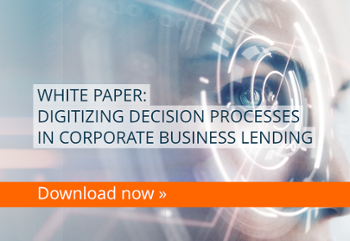
The digital era is leading to a paradigm shift on the financial services market as well as on the customer level. New suppliers, many of them fintech companies, are pushing into the market with product and service offerings. They have adapted to the new demands of customers – all online, all available at once. This becomes particularly clear in the lending business: fully automated online-offers for consumer loans, debt-rescheduling loans or car financing are just a few examples that demonstrate where the journey is heading. If customers are used to this digital service, they will naturally expect the same service in other business areas, such as corporate lending. But the Problem is: The data and system infrastructure of many traditional financial institutions are not allowing these services. Not only does this block the interface to the customer, it also endangers the long-term profitability of the company in the case of internal operations.
"Data is the gold of the 21st century." This frequently quoted statement by Matthias Hartmann, the former head of the Society for Consumer Research, cannot be dismissed, as many of the most valuable companies worldwide base their business model on this digital currency. This gold-rush mood is triggering the shift of many traditional offline services to the World Wide Web. As a result, customers are becoming increasingly used to digital processes and the associated convenience which they integrate into their daily lives. The upcoming digital-native generations will have a completely different understanding of service, process speed and interaction in all kind of services than the baby-boomer generation, which grew up in an analog way. And they will make different demands to their financial service provider.
Banks have substantial backlog
According to a study by the BearingPoint Institute and the Bavarian Financial Center (BFZ), only a few banks realized the growth potential of digitalization just a few years ago. In the survey of 48 European banks at the end of 2015, only 17 percent of the participants said they had achieved a high degree of digitalization. "The results show: Traditional banks need to rethink their business strategy and make significant investments in digital technologies. Fintechs, telecommunications providers and payment services from high-profile technology companies initiated the digital revolution. Well-established banks will not catch up if they do not exploit the full potential of digital tools. This also includes a smart analysis of customer data," says Dr. Felix Breuer, Managing Director of BFC.
Despite a late start, the trend is very clear: according to the Compass Banking 2017, by Sopra Steria Consulting Industry and the F.A.Z. Institute, 82 percent of companies in the financial sector are working on a digital strategy. The major goal of these companies is to increase cost efficiency and create more time for the development of new products and the optimization of processes by eliminating manual processes. Discernment through the prospect of increased efficiency.
In their first moves towards digitalization, banks have concentrated primarily on the less complicated retail banking. Payment transactions, security trading or the granting of loans to private customers are already electronically processed by many financial institutions and made available to users via an online interface. The next step into the much more extensive corporate banking and corporate lending business is often postponed, although it is precisely this area where great opportunities by automated processes remain untapped.
Enormous potential for automation in corporate credit processes
The corporate credit process is characterized, among other things, by the diversity of applicants, their features and the products required. Whether a joint-stock company or non-profit organization, a group of associated customers or a company that needs to be evaluated individually, whether an investment loan, a global limit for a credit card or structured financing with ten underwriters – all of this belongs to the corporate lending sector. Combined with multi-layered collateral structures, special financing objects (e.g. aircraft, ships or commercial real estate) and a long history of customer relations with corresponding specific agreements, it results in very knowledge-intensive processes.
Sophisticated processes consist of a high number of individual sub-processes and work stages. To create faster, more efficient workflows, the key success factor is to ensure that the individual work stages run as smoothly as possible – specific technological support is a decisive component.
 It is important to bear in mind that complex structures and circumstances are subject to constant change – new legislation with additional regulations, new internal work instructions and guidelines, etc. To react in a flexible and prompt way to such adjustments is a key competitive factor. It is therefore important that it is not only a "master process" that is defined but a smart solution architecture. The reusability, combinability and adaptability of the business solution components are decisive aspects. In this way, an adequately structured digital loan application template ensures the sustainability of the processes that have been developed.
It is important to bear in mind that complex structures and circumstances are subject to constant change – new legislation with additional regulations, new internal work instructions and guidelines, etc. To react in a flexible and prompt way to such adjustments is a key competitive factor. It is therefore important that it is not only a "master process" that is defined but a smart solution architecture. The reusability, combinability and adaptability of the business solution components are decisive aspects. In this way, an adequately structured digital loan application template ensures the sustainability of the processes that have been developed.
The lending business is changing
The lending business is undergoing a continuous process of change. Increased risks in granting loans, falling interest margins in times of increasing competition with new market participants and high processing costs in the back office are impacting the results of many banks. In addition, customers are becoming more demanding in terms of turnaround times and consulting services. The residential real estate credit guidelines WIKR and Basel III, in which the revised regulations of the Basel Committee of the Bank for International Settlements (BIS) have been laid down since 2013, are also gradually increasing the data management requirements of financial service providers. A loan decision that could previously be processed by the specific know-how of experienced employees now requires many additional parameters that must be considered.
To meet the customer's demand for more transparency and faster decision-making processes in this context, digitalization and linking of information is inevitable in the long term. This is the only way to look at loan decisions in the context of the entire customer history and to make system-supported decisions. This enables, for example, the parameters of a current linked corporate loan to be considered for pending private financing.
Conclusion
Many banks have a lot of work to do in the area of digitizing their processes. Even though the banking industry is slowly undergoing a rethinking, the customer's expectations are often already one step ahead of what financial institutions offer.
In addition to customer requirements, regulatory requirements, which are very strict in the banking sector, are also increasing. The number of parameters to be taken into account in loan decisions is growing continuously, while at the same time the decision-making processes must be accelerated and made more transparent to guarantee profitability.
A significant improvement can be achieved if credit applications are always processed in the context of the entire customer history. On the other hand, this presupposes that all relevant data is stored in digital format and made available to the clerk in a context-sensitive manner. The corporate lending business particularly offers high automation potential. By using a digital loan template, complex structures and facts can be automated step by step and considerable acceleration in the loan processing can be achieved.
Image Source: Teaser: anyaberkut - 874659590 - iStock








